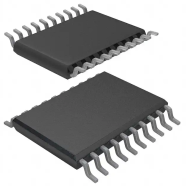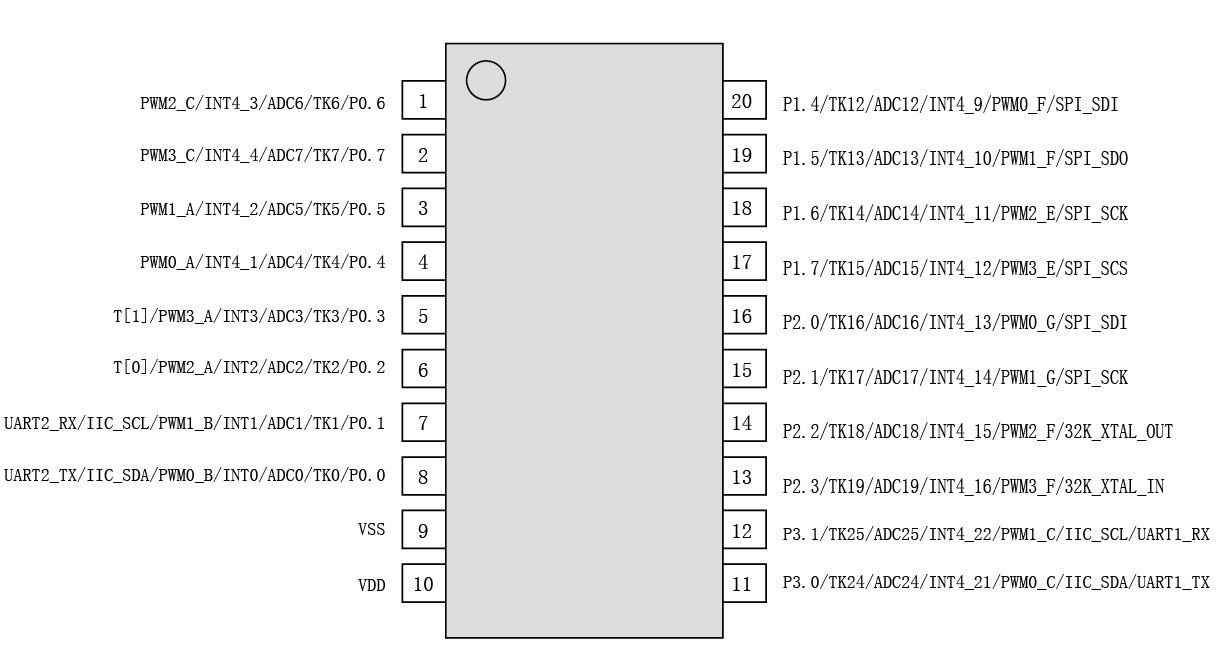CA51F152S4A
The CA51F152S4 series chip is an 8-bit microcontroller based on the 1T 8051 core, which not only retains the basic characteristics of traditional 8051 chips, but also runs 10 times faster than traditional 8051 chips in general, with superior performance. The chip is equipped with a 16KB Flash program memory, which can be programmed multiple times, and a 1KB SRAM to facilitate customer development of complex applications. It also integrates 18 channels of 12 Bit ADC, 18 channels of Touch Ke (y does not require external capacitors), 16 Bit PWM, I2C, 2 channels of UART, SPI, RTC, low voltage detection (LVD) and other functional modules. Supporting PWM, I2C, UART peripherals that can be mapped to any pin, supporting 8 high current pins, the software can achieve dual scan LED screen display function, and also supports IDLE, STOP, and low-speed operation three power-saving modes to adapt to applications with different power consumption requirements. Its powerful functions and superior anti-interference performance make it widely applicable in household appliances.

Product Details
kernel
CPU: 1T 8051, higher speed 10 times faster than traditional 8051
Compatible with 8051 instruction set, dual DPTR working mode
storage
Flash: 16K bytes, supports multiple repeated erasures
Flash can be divided into program space and data space, and the data space can be used to store the data that needs to be saved after power failure
RAM: 256 Bytes internal RAM, 768 Bytes external RAM
working voltage
Working voltage: 2.3V~5.5V
working temperature
Working temperature: -40 ℃~+85 ℃
Clock system
External low-speed oscillator: 32.768KHz
Built in low-speed RC oscillator: 128KHz
Built in high-speed RC oscillator: 16MHz, accuracy of ± 1% @ 25 ℃ (factory calibrated)
Voltage 2.7V~5.5V supports system clock 16MHz
Voltage 2.3V~5.5V supports system clock 8MHz
timer
Three 16 bit universal timers: Timer 0, Timer 1, Timer 2
Universal Input/Output Port (GPIO)
Supports up to 18 GPIO ports,
Supports push-pull, open drain, pull-up, pull-down, and high resistance modes
When push-pull output is used, the current of a single GPIO source can be higher up to 18ma@5v Higher current can be applied up to 40ma@5v
8 high current GPIOs (P0.0~P0.7), can be used for bright LED screen display
GPIO can be software simulated as a 1/2 BIAS LCD driver without the need for external resistors
TMC function
The clock source of TMC timer can be selected as IRCL or XOSCL
The minimum unit of interruption time is 512 IRCL clock cycles when the clock source is selected as IRCL, and 128 XOSCL clock cycles when the clock source is selected as XOSCL
The configurable interrupt time is 1-256 minimum unit times
Interrupt system
7 valid interrupt sources
Two level interrupt priority, supporting nested interrupts
5 external interrupt sources INT0~INT4
External interrupt trigger edge selection: INT0~1 (rising edge, falling edge), INT2~4 (rising edge, falling edge, double edge)
Interrupt input pin selection: INT0 (P0.0), INT1 (P0.1), INT2 (P0.2), INT3 (P0.3), INT4. Any GPIO pin except for P0.0~P0.3 can be selected as the interrupt input pin
Analog to Digital Converter (ADC)
Supports 18 channel 12 bit SAR ADCs
Supports two reference voltage sources: VDD and internal reference
Selecting internal voltage as the reference can measure VDD voltage
Touch Key
Built in touch sensing controller
Larger support for 18 touch channels without the need for external capacitors
High anti-interference performance, compliant with EMC (CS dynamic 10V, EFT 4KV) standards
Support touch interruption
Supports parallel connection of touch channels, which can be used to achieve low power consumption mode
PWM
Supports 4 PWM outputs, each path can be individually controlled, and the cycle and duty cycle can be freely configured within a 16 bit range
Supports direct output of internal clock function
Support PWM interrupt function
Each PWM output pin can be mapped to different GPIO pins
Universal Serial Interface (UART1/UART2)
Supports 2 full duplex serial ports
Supports 1-byte receive cache
The TX/RX function of UART1/UART2 can be mapped to different GPIO pins
I2C interface
Built in 1-channel I2C interface, supporting master-slave mode, standard/fast/high-speed mode
I2C pin SCL/SDA function can be mapped to any GPIO pin
SPI interface
Built in 1 4-wire SPI interface, supporting master-slave mode
Low Voltage Detection (LVD)
The detection voltage can be set to 2.2V, 2.5V, 2.7V, 3.0V, 3.3V, 3.6V, 3.9V, and 4.2V.
Low voltage reset or interrupt can be set
Reset mode
The chip supports multiple reset sources: power on/power off reset, soft reset, watchdog reset, low voltage detection reset
Watchdog
27 bit watchdog timer, 16 bit adjustment accuracy, configurable watchdog reset or interrupt
Program download and simulation
Supports ISP and IAP
Support online simulation function
low power consumption
STOP mode, current<7uA
IDLE mode, current<30uA
Low speed operation mode, current<55uA
Package type: SOP20

CA51F152S4A pin diagram


